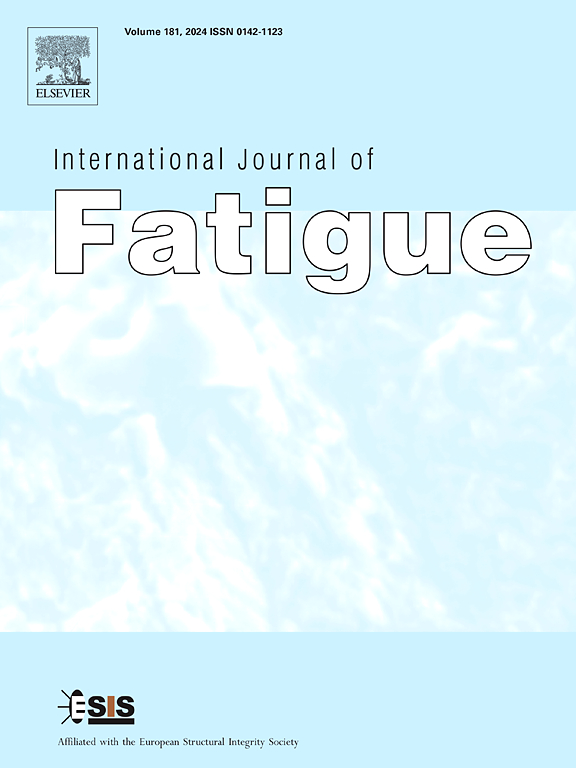A theoretical model for three-dimensional fatigue crack closure and growth under variable amplitude loadings
IF 5.7
2区 材料科学
Q1 ENGINEERING, MECHANICAL
引用次数: 0
Abstract
Fatigue crack closure (FCC) and growth (FCG) behavior under variable amplitude loading (VAL) are ubiquitous in engineering structures. With the plasticity-induced cack closure concept, Budiansky and Hutchinson (1978) pioneered the analytical FCC model under plane stress state and constant amplitude loading (CAL) conditions with stress ratio R ≥ 0. Here, we developed the analytical model into three-dimensional (3D) FCC and FCG under VAL, by which the FCG life under CAL as well as VAL can be predicted only based on the FCG data from the standard CAL testing, and free from any empirical parameters. Under CAL, the present model shows that the opening-stress ratio increases with increasing stress ratio and decreases with increasing applied maximum stress and 3D constraint levels, in good agreement with finite element and experimental data from the literature. Validations against one hundred and thirty-three experiments available from the literature, including eight materials and three types of specimens with through-the-thickness and surface cracks, show that the predicted FCG life is within 0.4 to 2.5 times of the experimental results under both CAL and VAL. It is found that the coupling effects of stress ratio, 3D constraint, applied maximum stress and load history on FCC and FCG can be effectively unified by the present theoretical model.
变幅载荷作用下三维疲劳裂纹闭合和扩展的理论模型
变幅载荷(VAL)作用下的疲劳裂纹闭合(FCC)和扩展(FCG)行为在工程结构中普遍存在。Budiansky和Hutchinson(1978)利用塑性诱导裂纹闭合的概念,首创了平面应力状态和应力比R≥0的等幅加载(CAL)条件下的解析FCC模型。在此,我们将分析模型发展为三维FCC和VAL下的FCG,通过该模型,可以仅根据标准CAL测试的FCG数据预测CAL和VAL下的FCG寿命,而不需要任何经验参数。在CAL下,该模型显示开口应力比随应力比的增大而增大,随外加最大应力和三维约束水平的增大而减小,与有限元和实验数据吻合较好。通过对文献中133个实验(包括8种材料和3种具有穿厚裂纹和表面裂纹的试件)的验证,结果表明,在CAL和VAL下,预测的FCG寿命都在实验结果的0.4 ~ 2.5倍之内。发现应力比、三维约束、外加最大应力和载荷历史对FCC和FCG的耦合效应可以通过该理论模型有效统一。
本文章由计算机程序翻译,如有差异,请以英文原文为准。
求助全文
约1分钟内获得全文
求助全文
来源期刊

International Journal of Fatigue
工程技术-材料科学:综合
CiteScore
10.70
自引率
21.70%
发文量
619
审稿时长
58 days
期刊介绍:
Typical subjects discussed in International Journal of Fatigue address:
Novel fatigue testing and characterization methods (new kinds of fatigue tests, critical evaluation of existing methods, in situ measurement of fatigue degradation, non-contact field measurements)
Multiaxial fatigue and complex loading effects of materials and structures, exploring state-of-the-art concepts in degradation under cyclic loading
Fatigue in the very high cycle regime, including failure mode transitions from surface to subsurface, effects of surface treatment, processing, and loading conditions
Modeling (including degradation processes and related driving forces, multiscale/multi-resolution methods, computational hierarchical and concurrent methods for coupled component and material responses, novel methods for notch root analysis, fracture mechanics, damage mechanics, crack growth kinetics, life prediction and durability, and prediction of stochastic fatigue behavior reflecting microstructure and service conditions)
Models for early stages of fatigue crack formation and growth that explicitly consider microstructure and relevant materials science aspects
Understanding the influence or manufacturing and processing route on fatigue degradation, and embedding this understanding in more predictive schemes for mitigation and design against fatigue
Prognosis and damage state awareness (including sensors, monitoring, methodology, interactive control, accelerated methods, data interpretation)
Applications of technologies associated with fatigue and their implications for structural integrity and reliability. This includes issues related to design, operation and maintenance, i.e., life cycle engineering
Smart materials and structures that can sense and mitigate fatigue degradation
Fatigue of devices and structures at small scales, including effects of process route and surfaces/interfaces.
 求助内容:
求助内容: 应助结果提醒方式:
应助结果提醒方式:


